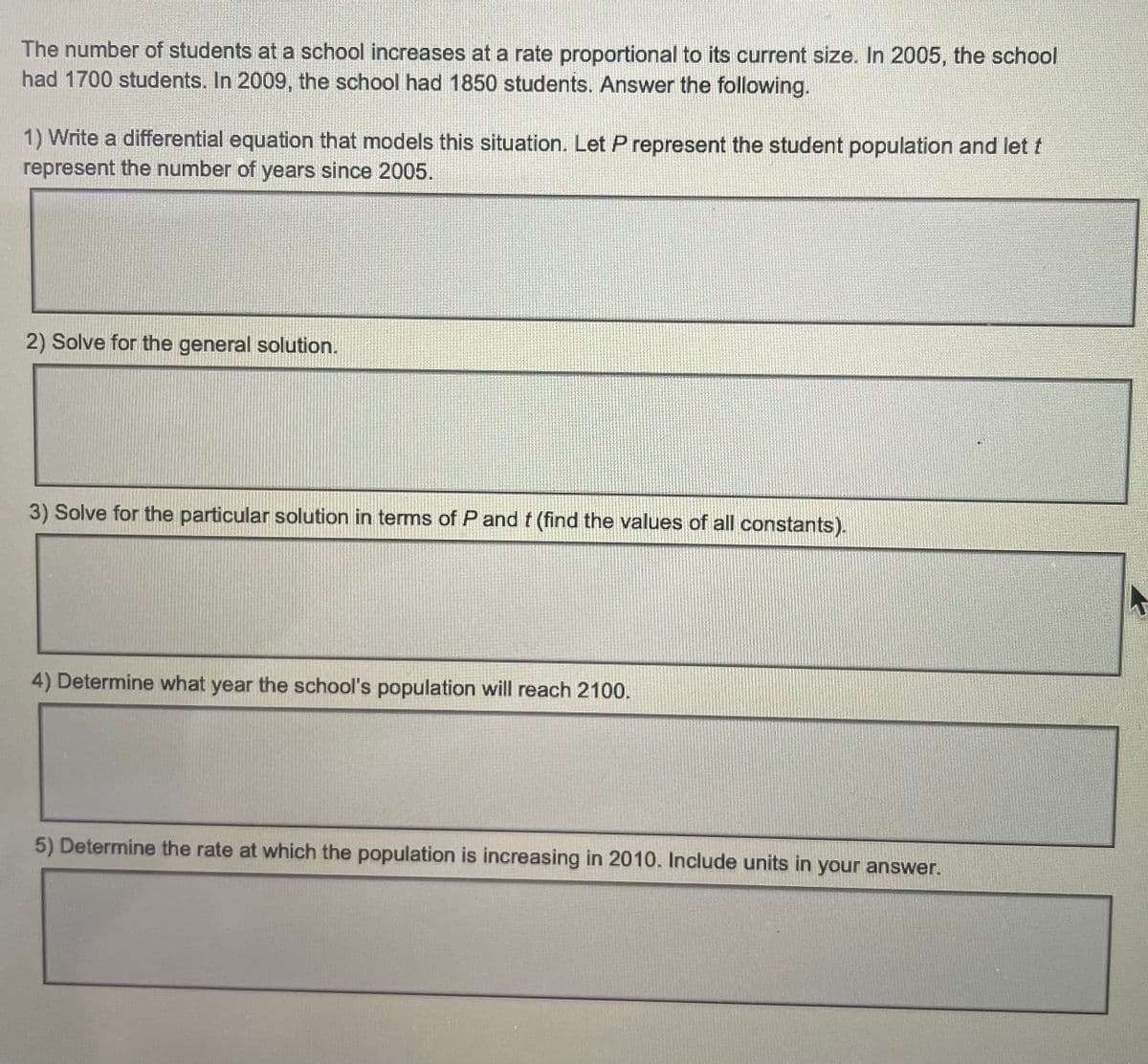The number of students at a school increases at a rate proportional to its current size. In 2005, the school had 1700 students. In 2009, the school had 1850 students. Answer the following. 1) Write a differential equation that models this situation. Let P represent the student population and let t represent the number of years since 2005.
The number of students at a school increases at a rate proportional to its current size. In 2005, the school had 1700 students. In 2009, the school had 1850 students. Answer the following. 1) Write a differential equation that models this situation. Let P represent the student population and let t represent the number of years since 2005.
Calculus: Early Transcendentals
8th Edition
ISBN:9781285741550
Author:James Stewart
Publisher:James Stewart
Chapter1: Functions And Models
Section: Chapter Questions
Problem 1RCC: (a) What is a function? What are its domain and range? (b) What is the graph of a function? (c) How...
Related questions
Question
just 4 and 5 please

Transcribed Image Text:The number of students at a school increases at a rate proportional to its current size. In 2005, the school
had 1700 students. In 2009, the school had 1850 students. Answer the following.
1) Write a differential equation that models this situation. Let P represent the student population and let t
represent the number of years since 2005.
2) Solve for the general solution.
3) Solve for the particular solution in terms of P and t (find the values of all constants).
4) Determine what year the school's population will reach 2100.
5) Determine the rate at which the population is increasing in 2010. Include units in your answer.
Expert Solution
This question has been solved!
Explore an expertly crafted, step-by-step solution for a thorough understanding of key concepts.
This is a popular solution!
Trending now
This is a popular solution!
Step by step
Solved in 4 steps with 23 images

Recommended textbooks for you

Calculus: Early Transcendentals
Calculus
ISBN:
9781285741550
Author:
James Stewart
Publisher:
Cengage Learning

Thomas' Calculus (14th Edition)
Calculus
ISBN:
9780134438986
Author:
Joel R. Hass, Christopher E. Heil, Maurice D. Weir
Publisher:
PEARSON

Calculus: Early Transcendentals (3rd Edition)
Calculus
ISBN:
9780134763644
Author:
William L. Briggs, Lyle Cochran, Bernard Gillett, Eric Schulz
Publisher:
PEARSON

Calculus: Early Transcendentals
Calculus
ISBN:
9781285741550
Author:
James Stewart
Publisher:
Cengage Learning

Thomas' Calculus (14th Edition)
Calculus
ISBN:
9780134438986
Author:
Joel R. Hass, Christopher E. Heil, Maurice D. Weir
Publisher:
PEARSON

Calculus: Early Transcendentals (3rd Edition)
Calculus
ISBN:
9780134763644
Author:
William L. Briggs, Lyle Cochran, Bernard Gillett, Eric Schulz
Publisher:
PEARSON

Calculus: Early Transcendentals
Calculus
ISBN:
9781319050740
Author:
Jon Rogawski, Colin Adams, Robert Franzosa
Publisher:
W. H. Freeman


Calculus: Early Transcendental Functions
Calculus
ISBN:
9781337552516
Author:
Ron Larson, Bruce H. Edwards
Publisher:
Cengage Learning